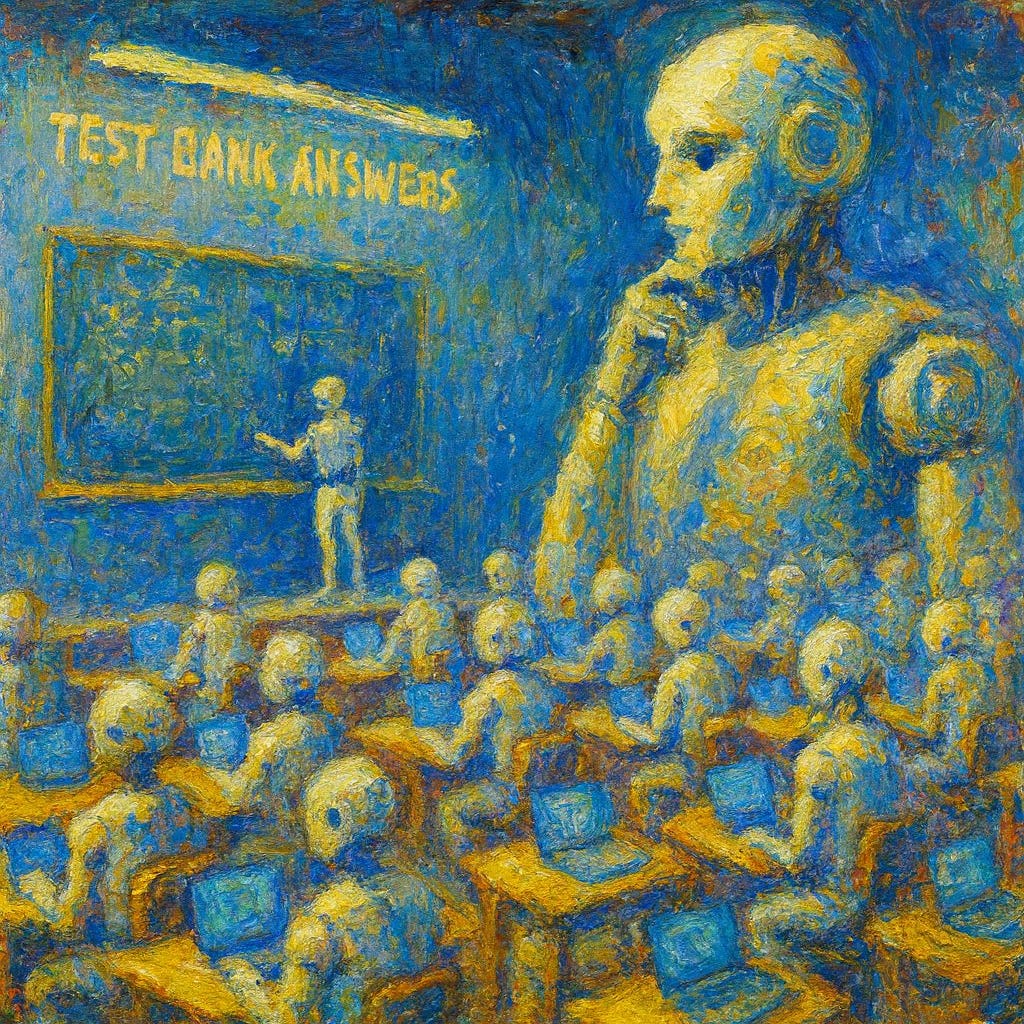Cap, Gown, and Empty Head
Credentialism’s great magic trick—making learning disappear without anyone noticing.
If you believe in the importance of free speech, subscribe to support uncensored, fearless writing—the more people who pay, the more time I can devote to this.
Please subscribe to receive at least three pieces /essays per week with open comments. It’s $6 per month, less than USD 4. And now take 50% off.
Everyone says, "Hey, it’s just a cup of coffee," but please choose my coffee when you come to the Substack counter. Cheers.
Some years ago, while teaching a Consumer Behaviour course, I made the mistake of trusting the academic equivalent of pre-packaged junk food: the glossy publisher’s test bank. It was, I confess, seductively convenient—cut, paste, strip out the answers, sprinkle in a few lines of academic boilerplate, and voilà: a midterm exam with none of the blood, sweat, or creative labour that writing one yourself requires.
Ah, the farce unfolded with exquisite predictability. Those pupils I'd charitably categorised as "amiable dimwits, destined for mediocrity" sauntered from the examination hall a full hour ahead of schedule, clutching scores in the lofty nineties—as if the ghost of enlightenment had suddenly visited them.
Meanwhile, my true scholars, those diligent souls who'd deigned to crack open the assigned tomes, remained bent double over their papers, grappling with queries that might as well have plummeted from some capricious deity's prankish heaven.
The crowning jest arrived courtesy of a smirking undergraduate, who, with the smugness of a cat presenting a half-eaten mouse, informed me: "They've got the test bank answers—you do know that, don't you?"
Alas, I did not. But from that enlightening debacle onward, I composed my infernal interrogations, questions and answers alike, lest the gods of academic sloth claim another victory.
The result? The miracle prodigies collapsed, and the actual thinkers rose to the top. It was the most damning demonstration of the modern university’s quiet fraud: the system now rewards the cheater, the memoriser, the hoop-jumper, and punishes the mind that tries to think.
Yeats famously wrote that education is not the filling of a pail but the lighting of a fire. In our time, the pail reigns supreme—filled to the brim with prefabricated answers and soon emptied again when the exam is over.
The fire, meanwhile, is not so much extinguished as politely smothered under administrative paperwork and “learning outcomes” written by people who wouldn’t recognise intellectual combustion if it set their office on fire.
The data is bleak. A U.S. study found that 45% of students showed no significant gains in learning after two years of college, and today’s students spend half as much time studying as their predecessors did a few decades ago.
A Higher Education Quality Council of Ontario report revealed that only 40% of fourth-year students could complete basic literacy and numeracy tasks. I once asked a student what six times nine was, and which province borders the Pacific Ocean. She went zero for two—but could, I am certain, have produced an annotated map of Kardashian romantic entanglements.
When I raised this with department heads and so-called academic experts, I discovered that the outrage was entirely mine. They smiled politely, shifted in their chairs, and changed the subject to “classroom fill rates” and “tuition income.”
In other words, the point was not to preserve the essence of learning but to keep the bodies coming through the doors and the payment systems humming. The lighting of fires had been replaced with the distribution of cheap, tawdry credentials—parchment as product, sold to customers who might once have been called students.
We have, in other words, in many cases, replaced education with credentialism. Publishers create test banks because instructors often won’t adopt their textbooks without them. Faculty—many of them underpaid contractors stitching together enough courses to survive—embrace them because they save time and ensure marks remain comfortingly high.
Administrators keep quiet because their business model depends on “bums in seats” until convocation day, when those bums put on polyester gowns and shuffle across a convocation stage for a handshake and a hoot from their siblings and family.
And students—well, a great many of them are only too happy to trade the arduous lighting of a fire for the mechanical filling of a pail, especially when the pail comes pre-filled.
Christine Cheng and Larry Crumbley’s 2018 study in the Journal of Accounting Education found that 48% of students used publisher test banks and enjoyed an average performance boost of 30%. In a saner world, this would be called “cheating.” In ours, it is described as “preparing strategically.”
It’s not just low-hanging fruit—it’s fruit rotting on the ground, in full view of everyone, and nobody wants to pick it up.
The rot runs deeper. This isn’t merely about dishonesty; it’s about the hollowing out of the very concept of learning. Multiple-choice regurgitation, particularly when lubricated by leaked answer keys, is not education—it’s its parody, the bureaucratic simulation of learning without the substance.
It teaches the lesson that process matters more than thought, and appearance more than reality. And the bright students who might have set fires of their own? They learn that idealism is for fools. Better to keep up with the cheaters than be punished for being honest.
One can hardly blame an employer for suspecting that, behind the embossed parchment and the solemn handshake, lurks a mind that would struggle to navigate its way out of a room with the door left invitingly ajar. The system has trained them to value the certificate over the skill, the grade over the understanding, the performance over the truth.
When a student journalist at the Toronto Star told me that this was a “non-story” because memorising test banks was just part of university life, I realised the depth of the rot. That’s like saying burglary is just part of home ownership.
What we have built is an education-as-theatre economy. The publishers get their sales. The administrators get their enrolment numbers. The faculty get their free evenings. The students get their GPAs. And the whole tottering edifice maintains the illusion of functionality while quietly ensuring that the pail is never too heavy to carry.
And now, into this pail-and-pantomime system, we have introduced AI. A 2023 study in Computers & Education: Artificial Intelligence found that over 40% of surveyed students admitted to using generative AI to complete assignments, often without any acknowledgement. Faculty confessed they could barely tell the difference between AI-written work and genuine student output. Detection tools? So unreliable they’re practically ornamental.
This is not a new road; it’s the same road, freshly paved. The move from memorising a test bank to feeding the same question into ChatGPT is not a leap—it’s a stroll in slippers. And the greatest scandal will not be that students use it, but that the institutions will quietly collude in its use. It will keep graduation rates up, tuition cheques flowing, and annual reports looking like success stories. The pail will now be virtual, rendered in flawless high-definition, and—like most things virtual—utterly empty.
Suppose the test bank years reduced Yeats’ noble fire to a lukewarm puddle. In that case, the age of AI threatens to do away with even that — offering instead a flawless hologram of a puddle: gleaming, untouchable, and entirely devoid of substance.
AI is not the enemy to be charged with lances; it is the new terrain. But it demands that educators learn to examine minds in ways the machine cannot mimic, rather than lazily outsourcing judgment to some wheezing plagiarism algorithm.
We will award degrees to individuals who have mastered the art of appearing as though they’ve learned something. And when those credentialled holograms are running our hospitals, our power grids, and our foreign policy, we will wonder aloud how it all went wrong. But by then, we’ll have nobody left who can give us the answer.
If you found value in this article and wish to support my ongoing work, please consider leaving a tip. Your support helps me continue producing uncensored content on critical issues.






It's most of the my university and it's an issue at many universities. I have seen students take exams with an open laptop with the answers to the side, students have told me that most of their classes use testbank answers that are available on Quizlet. I don't examine other instructor's exams, but when you hear the same message over years you believe it's true. What students say is the opposite of how you might phrase it - they say that I'm one of the few who doesn't use test bank questions. And I'm in enough trouble without trying to narc on the entire faculty.
It's amazing how disconnected learning has become from "education" - https://www.amazon.ca/Case-against-Education-System-Waste/dp/0691174652#:~:text=Caplan%20draws%20on%20the%20latest,useless%20degrees%20can%20certify%20employability.